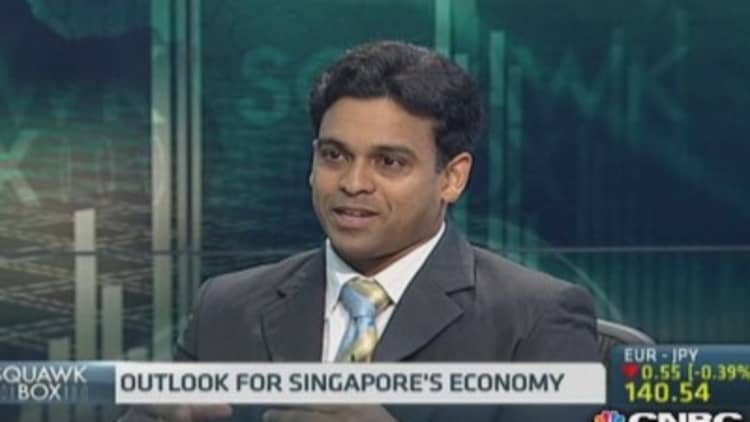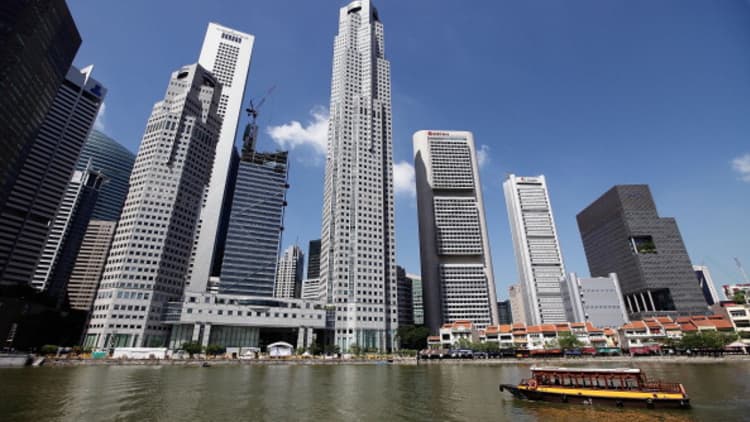
Following the moderation in Singapore's growth during the first quarter of 2014, economists warn the city-state's growth trajectory could be volatile for the remainder of the year due to domestic and external headwinds.
Singapore's economy expanded 5.1 percent on year in the first quarter of 2014, in line with Reuters' expectations, according to advanced estimates released on Monday. The reading was slower than the 5.5 percent on-year expansion in the final quarter of 2013.
On a quarter-on-quarter, seasonally adjusted and annualized basis, the economy grew just 0.1 percent, slowing from 6.1 percent in October-December period.
Read MoreCan Singapore become the 'Monaco of the East'?
"The gist is we're off to a slightly weaker start to 2014 - the growth profile will continue to be uneven because of the headwinds on both the domestic and external front," Selena Ling, head of treasury research and strategy at OCBC Bank told CNBC.
On the domestic front, Ling points to the city state's tight labor market which will act as a supply-side constraint on growth. The unemployment rate for Singapore citizens stood at 2.8 percent in December 2013, edging down from 2.9 percent in the same period a year earlier.
The Singapore government has announced a slew of measures to limit the influx of foreign workers in the recent years in response to public opposition to the country's liberal immigration policies and in a bid to boost domestic productivity. The measures have included lowering the foreign manpower dependency ratio for the manufacturing and services sectors. Foreigners - which make up around 40 percent of Singapore's 5.3 million population - are an important source of cheap employment, particularly for the country's manufacturing, construction and services sectors.
On the external front, the country's trade outlook is clouded by a slowdown in key trading partner China, Ling said. The mainland accounts for 12 percent of the country's exports, according to Trading Economics.
The world's second largest economy reported an 11.3 percent fall in imports in March, compared with the same period last year, reflecting subdued demand.
Seng Wun Song, regional economist at CIMB agreed the uncertain external demand environment could be a source of volatility for the economy.
Read MoreChina imports tumble in March
"If you look at Singapore's growth profile over the past 3 years – it's been fairly volatile in terms of growth reflecting uneven growth of the external sector. We expect this to continue because this is an export-oriented economy," he said. "We're keeping our fingers crossed that the recovery in developed markets will help to support Singapore's overall growth for the year."

Breakdown of the GDP numbers
The city-state's manufacturing sector was a bright spot, growing 8 percent on year following the previous quarter's 7 percent expansion, helped by a sharp rebound in biomedical manufacturing output and stronger growth in chemicals output.
The construction sector grew by 6.5 percent, up from 4.8 percent growth recorded in the preceding quarter, boosted by public sector construction activities.
Growth in the services producing industries, meantime, cooled to 4.7 percent, compared with 5.9 percent in the previous three months, due to slower expansion in the wholesale and retail trade and the finance and insurance sectors.
Going forward, Vishnu Varathan, economist at Mizuho Bank says construction will be an increasingly important driver of growth for the economy.
"The private sector's rush to build properties may be cooling. But we've got the public sector capacity expansion, train expansion, some public housing, port reconstruction, and thing like that moving along," Varathan said.
MAS stands pat on policy
Singapore's central bank also maintained its tight monetary policy stance on Monday, allowing a "modest and gradual" appreciation of the local dollar in order to guard against inflationary pressures.
The Monetary Authority of Singapore (MAS) conducts monetary policy by managing the rise or fall of the local dollar against the currencies of its main trading partners.
Read MoreTigerair will 'roar again': Tiger CEO
This policy stance, which has been in place since April 2012, was assessed to be appropriate, taking into account the balance of risks between external demand uncertainties and rising domestic inflationary pressures, MAS said.
"With inflation expectations on the high side, the labor market tight and business costs rising we don't think the MAS has room to relax anytime soon," Prakash Sakpal strategist at ING wrote in a note on Monday.


